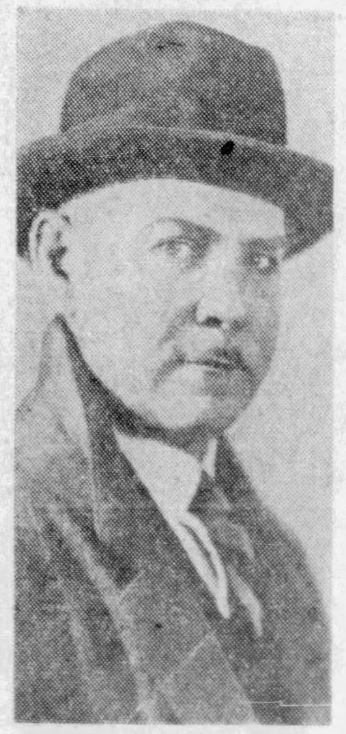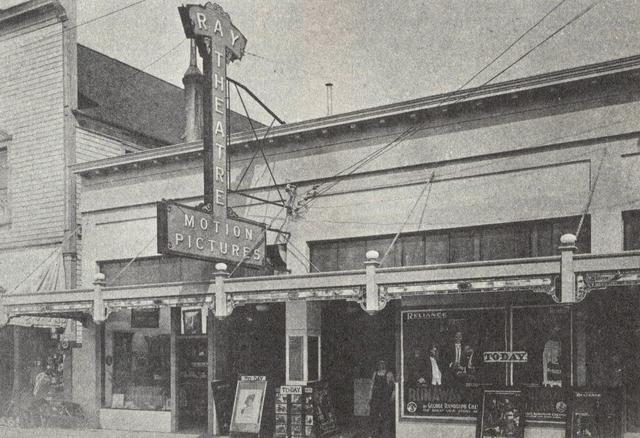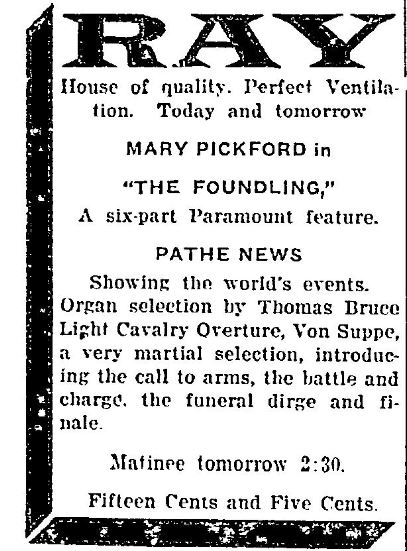During the silent movie era, films were anything but silent. Musicians lent their talents to give films life through musical accompaniment. One such musician was Olympia’s Thomas Bruce, a music teacher and composer. This pipe organist worked at the Ray Theater in the 1910s. He lived a life full of music.
Thomas Bruce: Music Man on Tour
Thomas Fitzjames Bruce was born May 4, 1884 in Shelby, North Carolina. The promising concert pianist attended Clemson University for three years before enrolling in the University of North Carolina at Chapel Hill’s music conservatory. Instead of graduating, he joined the army. After serving four years, he became a theater pipe organist. He would later claim that when he worked in Yakima in 1913, he was the first to synchronize his music to the film—and that Hollywood later took up the idea. He also worked in Calgary, Alberta.
A musical career would take him across the country, staying a few months or years in a place at a time. He ended up in La Grande, Oregon in 1909, where he married Margaret Grider. They had one son, William (1909-1998), but soon divorced. Bruce married Susie Burnett. The couple had one daughter, Helen, born in 1912. They later divorced.

Bruce Comes to Olympia
“Mr. Thomas Bruce, an accomplished organist,” announced the Morning Olympian on July 1, 1916, “will make his first appearance at the Ray tonight.” He accompanied the film “Alien Souls.”
Short comedies, newsreels and cartoons were shown alongside feature films. Thomas Bruce accompanied them and played during intermissions. Most tunes were classical and popular songs, but some he composed. He wrote an ad for “Madame Butterfly,” “the music alone is worth the price of admission.” Bruce also led the theater’s orchestra.
Besides the theater, Bruce taught music. He gave private lessons in pipe organ, piano, harmony and composition. On October 25, 1916, he opened a musical kindergarten at his family’s 318 East Sixth Street home, even buying a Dodge to transport students. Bruce brought his students, ages two through seven, to perform at the Woman’s Club in March 1917. He explained how he used fairy stories and colored charts to teach them opera. He had them sing the “Anvil Chorus” from “Il Trove” to the group, with lyrics about the seven dwarfs in their workshop from Snow White.

His music also reached a wider audience. In 1917, he wrote and directed “Little Miss Reveille” to benefit the Helping Hand Circle’s charity work. A two-act comedy, the story opened in San Francico’s Presidio at an army camp and the second act was set in the Philippines. The story had 15 musical numbers as well as a hula and ukelele chorus. Several songs by Bruce were played, including “Goodbye United States” and “Good Old Fruju for Me.” It was praised as “good from curtain to curtain,” at the Ray.
During World War I, Thomas Bruce helped the war effort. He played the organ during a community sing promoting the Liberty Loan in April 1918. Bruce also arranged a “Wild Jazz Night at Palm Beach” musical play that month at the Ray Theater to benefit the Red Cross. More tickets sold than seats were available at the Ray. A second performance was even held at the Camp Lewis YMCA.
Thomas Bruce Moves to Tacoma
In late 1918, Bruce moved to Tacoma to work for the Strand Theater. He continued to teach, opening the Bruce School of Music in the Bernice Building. His most notable achievement was a special score he created for “Auction of Souls.” Telling the story of the Armenian genocide through the eyes of survivor Aurora Mardiganian, the film was used to fundraise for Near East Relief.

Thomas Bruce Moves to Kansas City
After leaving Tacoma, Bruce worked at a theater in Oklahoma City before moving to Kansas City, Missouri. He played for several theaters, even drawing up plans for Mainstreet’s organ in 1925. He played the organ for the local radio station, beginning in 1923 – the first in the nation to do so, he later claimed.
In 1927 he opened Bruce School Inc., in the basement of the Community Center Church. The private music school grew from a handful of students as young as two into a full elementary. He continued to play organ for theaters. In 1931 he married Claryce Silver, an organ student. She ran the school with him.
But the most famous part of the school was the Bruce School Toy Symphony Orchestra. Students played percussion, bells, xylophone and violins. Bruce accompanied them on piano, playing classical and semi-classical music. He took 35 students, none over age seven, to the Century of Progress World’s Fair in Chicago in 1933. They gave daily concerts August 1-4 on the “Enchanted Island.” The students also performed at the 1939 World’s Fair in San Francisco.
Thomas Bruce Moves to Fresno
In 1941 the Bruces moved to Fresno, purchasing a vineyard and fruit orchard with his brother-in-law J.W. Silver. They even grew bananas! In 1946, the Bruces sold the school in Kansas City.
Bruce also purchased the Mecca Billiards in Fresno. A former Kansa City billiards champion, he drove into town most days to play billiards. He claimed his business was the only billiard theater in existence.
Bruce died on December 6, 1958. He was 74. His school continued into the 1960s. A 1939 ad for the film “Wings” at Kansas City’s Lindbergh Theater summed up his musical career: “If you haven’t heard him, you ain’t heard nothing yet.” Truly, Thomas Bruce lived a life of music.




















































